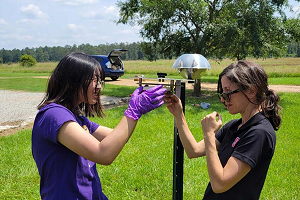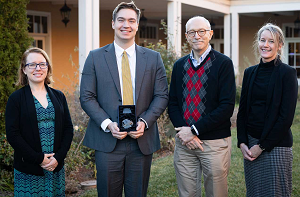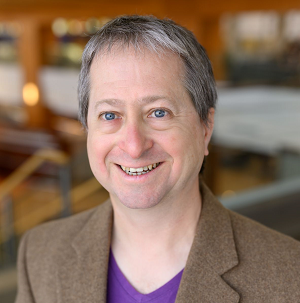Hot Off the Press
E-Factor Stories

LSU researchers set up measurement devices in Colfax. (Photo courtesy of LSU)
Oral Histories Shed Light on Environmental Injustice in Louisiana
Researchers at the Louisiana State University Superfund Research Program (SRP) Center interviewed residents to reveal historical effects of a thermal treatment waste facility in Colfax, Louisiana.
Collaboration and Training Key to Superfund Success
The annual grant recipient meeting of the NIEHS Superfund Research Program (SRP), held Dec. 4-6 in Albuquerque, New Mexico, showcased how collaborative research can accelerate scientific discovery to protect the health of communities exposed to harmful contaminants.

Mills at the SRP Annual Meeting alongside NIEHS Division of Extramural Research and Training Deputy Director Ashley Vargas, Ph.D., left; NIEHS and National Toxicology Program Director Rick Woychik, Ph.D., second from right; and SRP Director Michelle Heacock, Ph.D., right. (Photo courtesy of William Bledsoe)
Rollie Mills Wins 2023 Wetterhahn Award
Rollie Mills, a trainee at the University of Kentucky SRP Center, is the 26th recipient of the Karen Wetterhahn Memorial Award. Mills was selected for his work developing filtration membranes to protect communities exposed to harmful contaminants in water, as well as his commitment to igniting rural youth’s interest in science.
Extramural Paper of the Month: Natural Materials Can Remove Uranium and Arsenic From Water
A combination of limestone and a bone-like mineral called hydroxyapatite can remove arsenic and uranium from water, according to University of New Mexico SRP Center study.
Extramural Paper of the Month: Rapid-Imaging Method Leverages Machine Learning to Study Immune Cells
Researchers at the North Carolina State University SRP Center and small business collaborators developed a new approach that combines advanced imaging methods with machine learning to rapidly image and count neutrophils, a type of immune cell, in zebrafish embryos.
Extramural Paper of the Month: Culinary-Inspired Technique Removes Arsenic from Water
A new approach developed by researchers at the Harvard School of Public Health SRP Center improved the ability of carbon-based filters to remove arsenic from drinking water. This method, which is inspired by a cooking technique known as sous vide, may offer a cheaper and more practical solution to prevent arsenic exposure.
News Stories

The study was led by Hunter Moseley, Ph.D., a data scientist at the University of Kentucky. (Photo courtesy of Hunter Moseley)
Improved Machine Learning Technique to Reveal How Metabolites Are Created
Researchers from the University of Kentucky SRP Center are using machine learning techniques to help interpret how chemicals are processed, or metabolized, in the body. The team developed a new dataset that can be used in machine learning models to predict the metabolic pathway associations of chemical compounds.
SRP Seminar Series on the Complexity and Persistence of PFAS Compounds
SRP brought together several grant recipients and experts from other federal agencies to discuss new strategies and continuing challenges for PFAS site characterization. The three-session event, Tools for PFAS Site Characterization, included presentations on research efforts and tool development for sampling, monitoring, detecting, and characterizing PFAS.
Research Briefs
Using Earth Materials to Remove Metals Near Abandoned Mines
University of New Mexico SRP Center researchers developed a new strategy that uses a type of rock and a naturally occurring mineral to clean up water contaminated with arsenic and uranium — two of the most frequently detected drinking water pollutants in Tribal communities.
New Model Estimates the Effects of Dioxin on Liver Cholesterol
Michigan State University SRP Center researchers developed a computer model to determine the health effects of exposure to dioxins. The team used the model to combine data on exposures and known health outcomes to assess the overall risk chemicals could pose to health.
Mapping Microbe Interactions That Support PCB-Degrading Bacteria
Scientists at the University of Iowa SRP Center mapped interactions between microbes that may support the growth of certain bacteria that degrade polychlorinated biphenyls (PCBs), a harmful contaminant. By harnessing those microbial relationships, researchers could improve the bioremediation, or bacterial breakdown, of PCBs from the environment.
Hot Publications
Check out our Hot Publications page to see brief summaries of papers that have been featured in the monthly e-Posted Notes newsletter!
to Top



